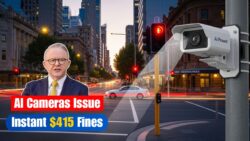Australia New Blue Reflector Road Rules – The newly exposed “Blue Reflector” road rules are gaining serious attention across Australia, especially among senior drivers who may not be familiar with the hidden changes being rolled out on local roads. These reflectors, placed in specific positions across the country, serve as quiet indicators for emergency-access points and crucial safety zones. With new warnings issued to older motorists, understanding how these blue markers work has become more important than ever. This guide explains the updated rules clearly, helping Australians drive confidently and avoid unexpected penalties under the 2025 road safety framework.

Blue Reflector Road Rule Update for Australian Citizens
The latest blue reflector rule update for Australian citizens is designed to improve emergency vehicle access and roadside water point identification. These reflectors, often overlooked by everyday motorists, signal hidden safety features that emergency services rely on. As more senior drivers return to longer road trips, understanding these critical blue markers becomes essential for safer travel. The rule update highlights how reflectors show locations where fire trucks can access water, especially in regional zones. For older motorists, this change ensures smoother navigation, reduced confusion, and better compliance with modern safety standards implemented nationwide.
 Australia Introduces $415 Rolling-Red Fine – AI Red-Light Cameras Now Catching Drivers Instantly
Australia Introduces $415 Rolling-Red Fine – AI Red-Light Cameras Now Catching Drivers Instantly
New Blue Safety Marker Guidelines for Australians
The government has introduced new blue safety marker guidelines for Australians to help drivers recognise emergency-use areas more accurately. Many senior drivers may not realise that a single blue reflector often marks a dedicated emergency water supply point, while a series of them indicates increasing proximity. These rules help prevent accidental parking or blocking of essential firefighting access. As road authorities raise awareness, Australians are encouraged to stay updated with signage, especially on rural highways. Understanding these guidelines can prevent fines, reduce road hazards, and improve community safety during bushfire seasons.
| Reflector Type | Meaning |
|---|---|
| Single Blue Reflector | Emergency water access point ahead |
| Two Blue Reflectors | Closer proximity to water point |
| Three Blue Reflectors | Exact location of water access |
| Blue + Red Reflector | Restricted or emergency-only zone |
| No Reflector | No emergency access nearby |
Updated Blue Road Indicator Rules for People Across Australia
The updated blue road indicator rules are now being promoted heavily for people across Australia, with senior drivers being urged to pay close attention. These indicators do not function like standard lane markers; instead, they are strategically placed on rural and semi-urban roads to highlight emergency infrastructure. Failing to understand them could lead to unexpected penalties or unintended blockage of vital water resources. As road networks continue to expand, authorities are working to simplify these rules through public campaigns, ensuring older Australians remain confident and fully informed while driving.
Emergency Blue Marker Awareness for the Canberra Government
The Canberra government has expanded its efforts to educate motorists about emergency blue marker awareness, emphasizing their importance during high-risk fire seasons. These reflectors form part of a national safety strategy used by both urban and rural fire authorities. The initiative aims to prevent drivers from obstructing water access points, especially during emergencies where minutes matter. By increasing public knowledge, the government hopes to reduce confusion among older drivers and ensure that Australia’s critical roadside infrastructure remains fully accessible year-round.
Frequently Asked Questions (FAQs)
 Centrelink’s November 2025 $250 Relief Payment – One-Off Boost for Age Pensioners Nationwide
Centrelink’s November 2025 $250 Relief Payment – One-Off Boost for Age Pensioners Nationwide
1. What does a blue reflector on the road mean?
A blue reflector indicates an emergency water access point used by fire services.
2. Are these new blue reflector rules mandatory?
Yes, all drivers must follow them to avoid penalties and ensure road safety.
3. Why are senior drivers being warned about these changes?
Senior drivers may not be familiar with the hidden updates introduced in recent years.
4. Are blue reflectors found on highways and city roads?
They are mostly found on rural or semi-rural roads but may appear near emergency zones.


